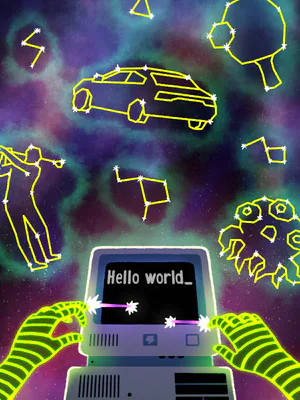As we honor South Asian Heritage Month, it’s essential to reflect on the rich tapestry of history that shapes the vibrant cultures of South Asia today. One of the most earnest foundations of this heritage is the Indus Valley Civilization, one of the world’s earliest urban cultures.
Before we go further into the topic of Indus Valley civilization, let's understand civilizations because it's a problematic word. Certain conglomerations of humans are seen as civilizations, whereas they’re nomadic cultures. The term "civilizations" can sometimes imply that other forms of social order are less developed or advanced.
So, What is a civilization?
Civilizations are typically characterized by social stratification, centralized government, shared values (often in the form of religion), and writing. In their early forms, they were almost always associated with rivers. Nowadays, you can build a city anywhere by dividing land into segments. However, 5000 years ago, civilizations were generally linked to river systems like the Yellow, Nile, or Indus. Now, let’s focus on our main topic.
The Indus Valley Civilization
The Indus Valley Civilization was situated in the floodplain of the Indus and Saraswati rivers. It was an ideal location for an ancient civilization because the rivers flooded reliably twice a year, providing plenty of resources. The civilization is known to have flourished around 3000 BCE, though trade with Mesopotamia began as early as 3500 BCE. It was the largest of the ancient civilizations, with over 1500 known sites.
What do we know about this civilization?
Our knowledge primarily comes from archaeology. Although the Indus Valley people used a written script, it remains undeciphered, and no Rosetta Stone has emerged to help us understand it.
We do know that they built impressive cities. Harappa and Mohenjo-Daro are the most renowned, featuring dense, multi-story homes made of uniformly sized bricks arranged in grid patterns. This suggests some form of government and urban planning, though the exact nature of this governance remains unknown.
The cities were designed to harness natural ventilation and were remarkably clean. Most homes were connected to a centralized drainage system that used gravity to carry waste and water out of the city through large sewer ditches beneath the main streets. This plumbing system would have been the envy of many 18th-century European towns.
In Mohenjo Daro, the largest public building was not a temple or a palace but a public bath, which historians call the Great Bath. We don't know exactly what the Great Bath was used for, but it's a significant structure that provides insights into the culture and practices of the Indus Valley Civilization. Since later Indian culture placed a huge emphasis on ritual purity, which is the basis for the caste system, some historians have speculated that the bath might have been like a giant baptismal pool, used for ritualistic cleansing and purification.
Also, they traded. One of the coolest things that the Indus Valley Civilization produced were seals used as identification markers on goods and clay tablets. These seals contained the writing we still can't decipher and several fantastic designs, many featuring animals and monsters. One of the most famous and frightening is a man with what looks like water buffalo horns on his head, sitting cross-legged between a tiger and a bull. We don't know what's going on here, but it's safe to say that this was a mighty dude because he seemed able to control the tiger.
How do these seals let us know that they traded?
Well, because we found them in Mesopotamia, not the Indus Valley. Plus, archaeologists have found stuff like bronze in the Indus Valley that is not native to the region. So what did they trade? Cotton, cloth
But here's the most fantastic thing about the Indus Valley people. They were remarkably peaceful. Despite archaeologists finding 1500 sites, they have seen very little evidence of warfare and almost no weapons. This is a stark contrast to many other ancient civilizations, which were often characterized by frequent conflicts and militarization. The peaceful nature of the Indus Valley people is a testament to their unique societal structure and values.
Before we talk about the fascinating Indus Valley Games, it’s time to learn about the demise of the Indus Valley Civilization.
What happened to the Indus Valley Civilization?
So, what happened to the Indus Valley Civilization? Well, here's what didn't happen to them. They didn't morph into the current residents of that area of the world, Hindu Indians or Muslim Pakistanis. Those people probably came from the Caucasus. Instead, sometime around 1750 BCE, the Indus Valley Civilization declined until it faded into obscurity. Why? Historians have three theories, but the truth remains a tantalizing mystery.
Conquest - Lack of military strategy or weapons, and it's possible that others overran people from the Indus Valley.
Environmental Disaster: It's possible they brought about their own end by destroying their environment.
Earthquake—The most interesting theory is that a massive earthquake changed the course of the rivers so much that many of the tributaries dried up. Without adequate water supplies for irrigation, the cities couldn't sustain themselves.
We don't know why the Indus Valley Civilization ended, but we also don't know why it started. Why did these people build cities, dig swimming pools, and make unnecessarily ornate seals? Were they motivated by hunger, fear, or need to be near their sacred spaces?
Thinking about what motivated the Indus Valley people to build their sophisticated cities and innovative features helps us reflect on our creative journey. At Studio Saffron, we are committed to fostering innovative ideas, working together effectively, and continuously striving to achieve the highest standards in everything we do. Our unwavering commitment to our core values: Collaboration, Ingenuity, and excellence, ensures that we are always working towards our goal of being the best.
Some fun games on internet about Indus Valley Civilization:
Indus - Valley of the forgotten
https://play.google.com/store/apps/details?id=com.MellowFoxStudios.Indus
In Indus: Valley of the Forgotten, an immersive strategy game that transports players to the ancient Indus. Players navigate through a series of dilemmas and events, swiping left or right to make choices that impact four critical aspects of their civilization: religion, money, people, and the army. Each decision has far-reaching consequences, affecting the stability and growth of your kingdom. Players must carefully balance these elements to ensure their reign lasts as long as possible.
Indus Valley - PC Game
https://gorbie8.itch.io/indus-valley
Indus Valley is a puzzle game in which you combine different objects inside the world to create new objects in hopes of aiding our escape. A trusty merchant accompanies us on these adventures and can be turned to, for clues on how to solve the puzzle. So far, there is only one level, but this game will be available on itch.io and will be updated frequently with new levels.
Indus 2500 BCE
https://mozaicgames.com/products/indus
Indus 2500 BCE is a flip-and-write game in which, on each turn, players either pick a terrain card from the market and draw the pattern as shown (including walls to protect against calamities) or reserve resources to build more advanced buildings. The game continues until a calamity card shows up to destroy areas of the meticulously built city. The game ends immediately once a second calamity card is drawn and resolved.




















1 comment